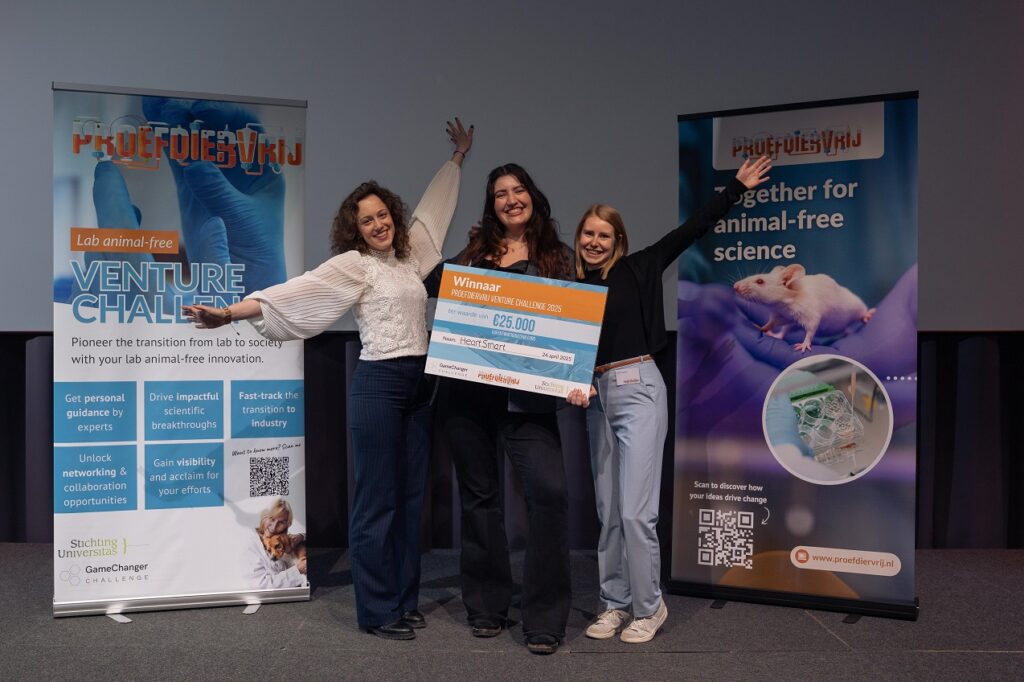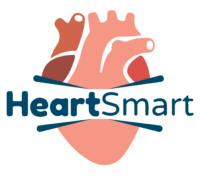Yesterday, on World Laboratory Animal Day, a team of scientists named HeartSmart won the anniversary edition of the Proefdiervrij Venture Challenge. With the prize money of €25,000, the team will bring their animal-free heart model to market. The prize was presented in the presence of scientists, entrepreneurs and students during the annual Proefdiervrij Event, this year at a very appropriate location: Corpus in Leiden.
Four promising teams worked under the guidance of experts over the past three months to make their animal-free innovations business proof. After all, animal-free innovations that remain on the shelf still do not replace laboratory animals.
This is why five years ago we launched the Proefdiervrij Venture Challenge: a business bootcamp for promising animal-free innovations, to bridge the gap between science and market.
HeartSmart’s animal-free heart model: fast, efficient, accurate
The heart model developed by HeartSmart’s Renée Moerkens, Milica Dostanic, Isabel Sariol and Dennis Nahon is a groundbreaking animal-free method of looking at fibrosis, the stiffening of heart tissue. Fibrosis prevents a heart from beating properly. The model consists of cultured human heart tissue and measures the force of contraction of a healthy and a diseased heart.
With the model, researchers can predict what effect drugs will have on a human heart. To do so, they need 95 percent fewer cells and other material than traditional methods. This makes their way of testing drugs not only unprecedentedly accurate, but also faster and more efficient.

Not just lab animal-free, but completely animal-free
But HeartSmart went one step further: from animal-free to animal-free. For many other test models consisting of cultured heart cells, Matrigel is used. This stuff that cells grow well on is harvested from tumors of mice, which are deliberately made sick for this purpose. So with the development of a Matrigel-free synthetic hydrogel, HeartSmart is establishing a cell model that is not only animal-free, but completely free of animal material.
But HeartSmart went one step further: from animal-free to animal-free. For many other test models consisting of cultured heart cells, Matrigel is used. This stuff that cells grow well on is harvested from tumors of mice, which are deliberately made sick for this purpose. So with the development of a Matrigel-free synthetic hydrogel, HeartSmart is establishing a cell model that is not only animal-free, but completely free of animal material.
Success stories from the Proefdiervrij Venture Challenge
Winning this prize bodes well for the future of Heartsmart’s animal-free model. Previous winners of the Proefdiervrij Venture Challenge made a nice kick start with their brand new business plan and the prize money in their pockets. For example, the mini-organ built from liver cells by Hello R&D is now being used by companies. The VR-model of Avatar Zoo is applied in anatomy lessons at Utrecht University.
Strong competitors
That HeartSmart took home the prize is well deserved. But the competition did not make it easy for them. Nydus R&D develops brain models that replace laboratory animals in neuroscience research. 2ndB builds a brain-on-a-chip that allows you to measure brain signals. And BioGrid makes organs-on-chips more accessible and affordable.
As a result, practice in recent years has shown that not only winners of the Proefdiervrij Venture Challenge are high achievers: ten former participants are still developing their models further, four of them are almost ready to launch a company.
The award ceremony: not talking about, but working on
The presentation of the award for the best business plan traditionally took place on World Laboratory Animal Day, during the annual Proefdiervrij Event, where scientists, entrepreneurs and investors come together to shape the future of animal-free research. This year’s event was all about action: not just talking about innovation, but working on the next step – ensuring that as many researchers as possible adopt animal-free technologies.
Completely in line with HeartSmart’s achievement: these ambitious researchers not only developed an innovative animal-free heart model, but also took that next step. And with success! We can’t wait to see how many researchers will use their model to learn more about the human heart and test new drugs.


